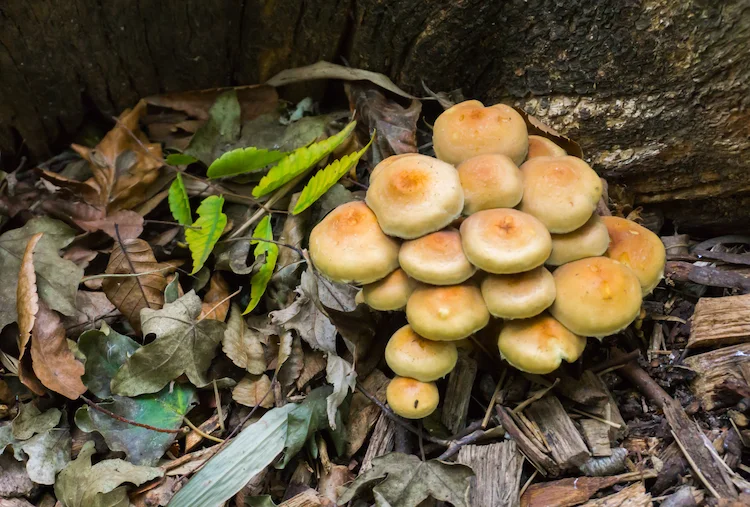Fungi often develop in your garden beds, as gardens create many favorable conditions for their growth. Why do I have mushrooms in the raised bed? Are they problematic? Or do they bring advantages for the garden? What can you do if you want to get rid of them? We answer all of these questions in this post!
Fungi spread by spores they emit into the air, and they grow where the spores land. If mushrooms are growing in your garden bed, it’s probably because spores are already present in the soil. These spores form deep fungal networks called mycorrhizae, which encourage the growth of new plants by providing them with water and nutrients.
What favors the growth of fungi
Raised beds create some conditions that favor the growth of fungus. Mushrooms like high humidity and raised beds are usually moist enough for not only the plants to thrive, but also the mushrooms. Shady areas between the beds are also very suitable for mushrooms. These shady areas make for a cooler, wetter environment that’s perfect for mushrooms. Warmer soil is also preferred by fungi and the organic matter is a perfect food source.
Raised beds with higher humidity and slower drainage are more susceptible to fungus, and they can develop very quickly if the garden is not well tended in late summer and fall. Untreated wood used for raised beds also creates perfect conditions for mushrooms. If you have a slightly alkaline soil in the garden, e.g. B. by over-fertilization with calcium, the growth of fungi is also promoted.
If the soil is not compacted, this can be another reason why mushrooms grow in the raised bed. The lack of compaction creates a more favorable environment for the growth of mushrooms.
Mycelia are present in all compost and soil, so there’s a good chance you have fungus growing in your garden, even if you’ve never noticed it. Because of the above conditions, raised beds are the ideal space for mushroom mycelia to thrive and mushroom fruiting.
Are mushrooms in the raised bed a problem?
Are mushrooms in raised beds good or bad? Mushrooms are not actually a problem in raised beds and are not a cause for concern. It can be said that they even have some benefits for your plants. Do you know that mushrooms actively produce nutrients? They can generate their own nutrients and they don’t depend on plants for survival. Fungi can even help improve soil quality for plants. They help break down foliage, much like worms and mycelia form symbiotic relationships with deciduous trees and shrubs.
Because fungi help break down organic matter in the soil, plants can access important nutrients and moisture more easily.
Most mushrooms are harmless, however, some mushrooms are poisonous to humans, but they are rare. If you don’t like the look of mushrooms or are afraid of certain poisonous varieties, you can easily remove them from your raised beds.
Note: Do not consume mushrooms from your garden beds without consulting a mushroom expert.
How to get rid of unwanted fungus in the raised bed
What to do against fungi in raised beds? It’s very easy to get rid of mushrooms in raised beds once you spot them. Remove them before they sporulate. It will take a few years for fungi to completely disappear from your raised beds. You must remove them regularly. Wear gardening gloves.
Are there home remedies for fungi in raised beds? Some gardeners recommend raising the acidity with liver of sulfur or vinegar to help the fungus go away, but raising the acidity enough to get rid of the fungus will also destroy the rest of the soil’s health. This leaves the only good way to pick the mushrooms by hand.
How to prevent fungi outdoors
So that you don’t have to fight fungus in the raised bed when it’s too late, there are some measures you can take to prevent them.
The first and easiest way to prevent fungus is to dry out the soil. So fungi have no opportunity to multiply. Provide good drainage. This is very important, as this is how you maintain proper humidity. So make sure the liner has holes in it to allow moisture to escape, and next year mix finer compost into the soil to improve drainage. Also make sure the bed is sloped to allow water to drain away. Only use well-rotted manure for your raised beds so you don’t encourage mycelia to grow. Topping your compost pile with fresh manure will spread the fungus and will inevitably return in the fall. Increase airflow by cutting back any plants that impede airflow. If you have the option of using stone raised beds instead of wood, that would also be a great way to prevent fungus. Raised beds made of wood are notorious for fungal infestation, especially on the shady side of the bed. If you are using wooden raised beds, treat the wooden sides with a 50:50 mixture of vinegar and water. Encourage animals in your garden. Squirrels, hedgehogs, rabbits, deer and snails also love mushrooms. Hedgehogs in particular love these tasty snacks and tend to avoid the rest of your crops, making them the most suitable for eliminating fungus from your raised beds.
